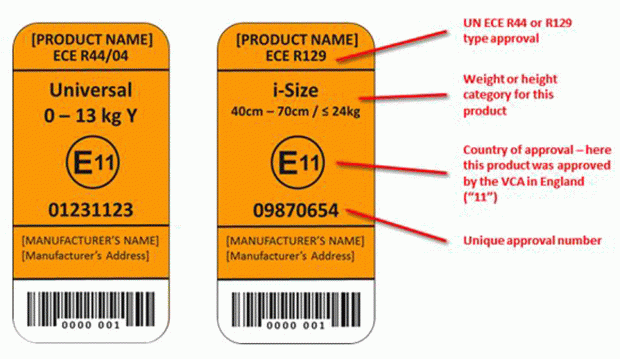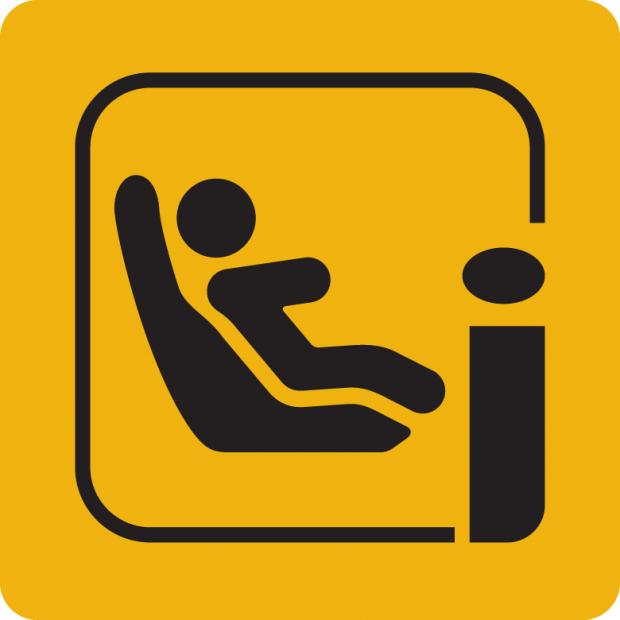How Often Do You Have to Charge a Carseat for Babies
Kid car seats, restraints and seat belts
Children are much more vulnerable than adults in a machine so taking time to make certain you use the right child seat (restraint) or booster correctly, could salvage your kid's life. Drivers and passengers are more probable to be killed or seriously injured when they don't wear a seat belt.
Child machine seats, restraints and the law
You must use the right car seat for your child in:
- cars
- mini buses
- vans
- other goods vehicles
The driver must make certain that whatever child nether 14 years old uses a seat belt or the right child restraint. Any child restraint used must conform to EU safe standards that is either Regulation 44.04 or Regulation 129 (too known as i-Size seats).
All children up to 135cm (approximately 4ft 5in) in height, or upward to 12 years of age (whichever occurs get-go), must use a suitable kid restraint – that is, 1 that is suitable for your child's pinnacle or weight.
There is a fixed penalty fine of £60 and iii penalty points for not using the correct child restraint. If the case goes to court, this could increase to a maximum fine of £500 for whatever occupant anywhere in the car.
Birth to three years of age
Children nether three years of age must apply a suitable child restraint. There is only 1 exception:
- a kid under iii may travel unrestrained in the rear of a taxi or a minibus if the right child restraint isn't available
Rear-facing baby seats must non be used in a seat protected past a front end air-bag unless the air-handbag has been deactivated.
From iii to 12 years old
In vehicles where seat belts are fitted, children from 3 years to 12 years and upward to 135cm in height (near 4ft 5in) must apply the right child restraint.
Three exceptions let these children to travel in the rear of the vehicle with the employ of an adult seat chugalug:
- in a taxi if the right kid restraint is not bachelor
- for a short distance, in an unexpected necessity - if the right child restraint is not bachelor
- where two occupied child restraints in the rear foreclose the plumbing fixtures of a third child seat and no suitable child restraint is available for use in the front passenger seat
There is also an exception for children with a a medical certificate saying that it is not advisable on medical grounds to article of clothing a seat chugalug.
A child taller than 135cm must wear a seat belt where 1 is fitted.
Children 12 to xiii years or over 135cm in superlative
Children anile 12 or 13 years or over 135cm (regardless of historic period) in height must wear a seat belt where one is fitted.
Summary of seat belt and child restraint requirements
Choose the right child car seat for your child
You should choose a child machine seat or restraint based on your child's pinnacle or weight.
There are ii European standards for kid restraint systems. These are Regulation 44 and Regulation 129 (or i-Size). Seats manufactured to either standard will have a label showing a capital letter 'E' in a circumvolve - as shown in the motion-picture show.

The characterization will show which standard the child car seat meets – Regulation 44 or Regulation 129 (i-Size). Regulation 44 kid motorcar seats are based on weight with an historic period recommendation. Regulation 129 (or i-Size) child car seats are based on height/ length and have a maximum weight. The characterization volition tell you the weight or maximum height/ length the kid car seat is designed for.

Regulation 129 will supplant Regulation 44 seats. Until and then, seats manufactured to either standard are safe and legal when used properly.
Cheque the label to make sure information technology's suitable for your kid and just employ it in keeping with the manufacturer'southward instructions.
When buying a child restraint, if possible, try it in your car before you buy. Not all seats volition fit or be suitable for your car. If y'all plan to employ your kid machine seat in more than than 1 motorcar it is important to check that it fits other cars besides. Speak to the shop sales adviser who will give you advice and may show you how to fit the restraint correctly.
ROSPA website has data and tips on choosing and using child car seats.
Types of child restraints
A kid restraint is the collective term for rear facing baby seats, forward facing child seats, booster seats and booster cushions.
Manufacturers may use different names and some products may embrace more than 1 weight or height so it is important to read the label.
Regulation 44 kid car seats
Regulation 44 kid car seats are based on weight with an age recommendation and are divided into 5 weight groups:
Regulation 129 child car seats
Regulation 129 child car seats are based on length / height, take a minimum weight and are also known as i-Size seats. Child machine seats approved according to Regulation 129 volition exist phased in over time. In the first stage (which is already in place) manufacturers are producing child car seats suitable for children up to 105cms – around four to 4 and a half years of age:
- the first phase i-Size child car seat is designed for children from birth upwardly to 15 months and must be rear-facing - this will arrange a kid with a length/height upward to nearly 83cm
- as well as the size range (length/ elevation) a maximum weight - upwards to which the child car seat tin exist used - is shown - then it is as well important that you know the weight of your child
- each child restraint manufacturer will specify the length/ meridian range and maximum child weight for their product
- it is possible to go along your child in a rear facing seat across xv months to 105cm length/ meridian - frontward facing child automobile seats can be used from 15 months but you should delay this as outlined below under 'Use the restraint correctly'
- information technology is important to bank check the label to make sure the kid car seat is suitable for the length/ tiptop of the child using it and that you discover the maximum weight allowed
Use the restraint correctly
Every year likewise many children are killed or seriously injured on the roads – ofttimes considering they are not properly restrained when travelling in a car. And then make sure you understand the law and give your child the best possible protection.
Many seat experts believe that information technology's better and safer to keep your kid in the everyman group seat for as long as possible. This ways staying in their electric current stage seat until the maximum weight or height limit is reached. Considering children grow and develop at different rates it is important to keep a sentry on your child's height and weight to make sure that they don't motion up a stage as well early or too late.
You must only use a kid restraint if your car's seat belt has a diagonal strap, unless the child restraint is:
- specifically designed for apply with a lap seat belt simply
- fitted using ISOFIX anchor points
Checklist
- check the characterization to make sure the child car seat is suitable for your child's weight and superlative
- fit the child restraint properly - follow the manufacturer's instructions
- every trip - permit time to get the child comfortably strapped in
- where using an developed chugalug to secure the restraint - brand sure it passes through all the right slots
- make sure that the child restraint is tight in the developed seat
- make certain that the adult seat belt buckle is not aptitude over or resting on the child restraint frame
- never fit a rear-facing restraint with an active airbag in front of information technology
- check the vehicle handbook and follow the advice about children and airbags - where fitted
- deactivate whatever front airbags earlier fitting a rear-facing (infant) restraint in a front end seat
- never modify the restraint or adult seat belt to make it fit
- never fit a child restraint in side-facing seats
Booster seat rules - no change for existing seats
- rules are now in force for backless booster seats (booster cushions)
- the rules apply to both Regulation 44 and Regulation 129 i-Size backless booster seats
- this means that manufacturers are not allowed to introduce new models of backless booster seats (booster cushions) for children shorter than 125cm, or weighing less than 22kg
- this change to technical standards ways that the range of products available on the market will be better suited for younger children
- nonetheless the rules practise not affect existing models of booster seats and booster cushions - parents can go along to use existing models bachelor -if the labelling indicates that they are suitable for their child
- the cardinal message is to check the label of the backless booster seat (booster absorber) that yous are using or looking to buy - if the label shows that it is suitable for the kid that you are carrying - you will not be breaking the police
More useful links
- Kid car seats
- Good Egg Car Safety
Source: https://www.nidirect.gov.uk/articles/child-car-seats-restraints-and-seat-belts
0 Response to "How Often Do You Have to Charge a Carseat for Babies"
Post a Comment